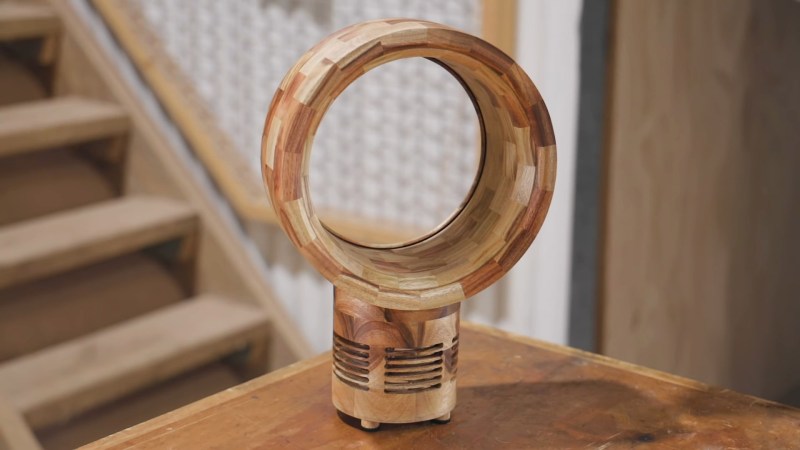It’s a simple enough premise: to make a Dyson-style bladeless fan out of wood. The execution of the finished fan, done and filmed by [Neil] from Pask Makes on YouTube, is however spectacular. Using nothing but scrap wood from a chopping board business local to him, he’s made the entire body of the fan using some interesting fabrication methods.
To plan the circular design of the body, [Neil] used an online calculator to measure the specific cuts of wood he needed in order to form cylinders out of trapezoidal sections glued together. Once the rough shape is made, he then used a profile template to turn the air channel with precision out of the two main parts of the fan body. Then, he uses SketchUp in order to figure out what shape needs to be cut from the base in order for the top to fit on it. From there, it’s just a matter of drilling out slots for the air intake, which he does so with an ingenious custom jig, and fitting the internals of a standard fan into the new wooden body.
The video, which you should definitely watch after the break if you have a spare half hour, might not be detailed enough to be used as a tutorial, but it certainly outlines his methods and the tools used well enough to impress us. And the finished build is beautiful to look at, too! If you’re looking for more impressive woodworking, we’ve covered this gorgeous recreation of a Commodore 64 case in wood. But if the hand-built nature of that doesn’t satisfy you, here’s a professional-looking custom caliper case made with CNC and laser engraving.
[Thanks to Tobias for the tip!]
















That feeling of excitement when you see a hack you submitted a tip for, then someone else with the thanks at the end
Sorry! We appreciate every single tip sent our way, but sometimes there are duplicates or they simply get lost in the sea. Thank you for sending in tips, though!
Been there, been done by that.
I remember the HaD of yore, where I submitted a buttload of cool stuff, and never was to be seen again. This is better.
This is really cool, but to have an actually usable device you would really need a centrifugal fan, not an axial type fan.
Why? Where/how would you mount it? It has to blow air from the bottom to the top of the support cylinder, while the centrifugal blows air in a radial fashion, axial seems more appropriate to me.
As far as I know, the Dyson style fans rely on creating a low pressure zone in the center of the ”fan”. This creates a sort of blow-by effect that promotes greater airflow than just the base fan that powers it could achieve.
The main benefit of ditching the axial fan for a centrifugal may be a reduction in pressure losses (and therefore energy loses).
But that is a big maybe, because I’m not sure how energy efficient the turbine style fan is when compared to an axial one
Thanks. Interesting read here https://electronics.howstuffworks.com/gadgets/home/dyson-bladeless-fan2.htm
You can’t suck and blow at the same time and since this blows it certainly doesn’t suck.
Here in New Mexico, we blame our spring wind on Texas and Arizona. Arizona blows and Texas sucks – we like to blame other states for our problems even at the lowest levels….
You can’t blow without drawing air from somewhere . That would creat a vacuum , and no air could move .
Excellent wood work
Dyson could commercialize this at a premium. This maker might get a job.😉
Or…. They could sponsor a build using their internals for this housing.
Beautiful piece, reminds me of the Wright brothers early wind tunnels:
https://www.nationalmuseum.af.mil/Visit/Museum-Exhibits/Fact-Sheets/Display/Article/196756/wright-brothers-1916-wind-tunnel/